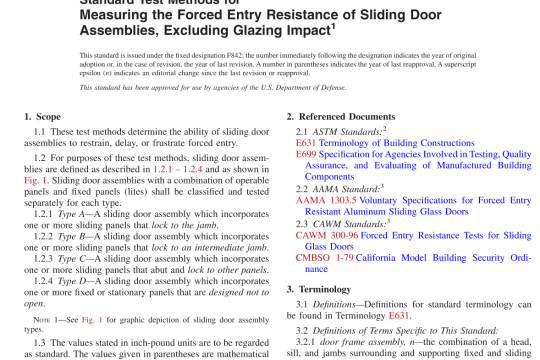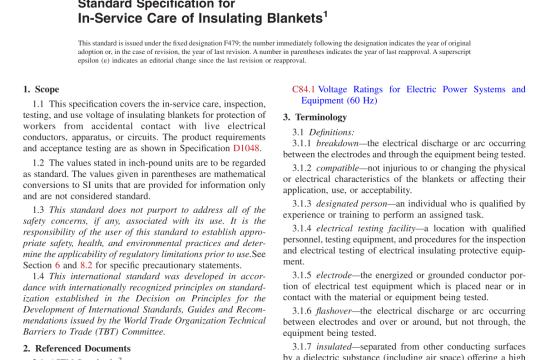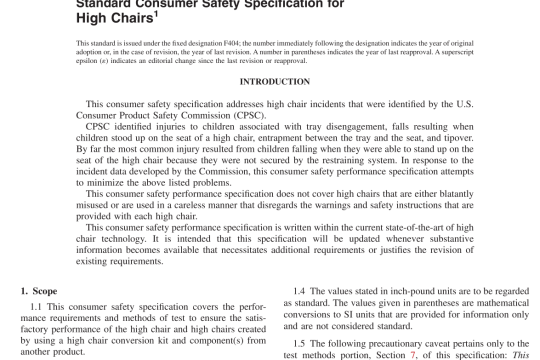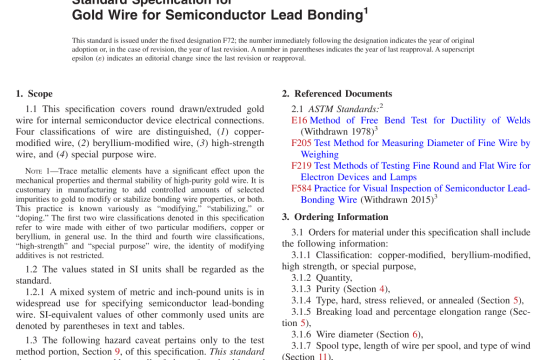ASTM D4511-11(R2020) pdf free download
ASTM D4511-11(R2020) pdf free download.Standard Test Method for Hydraulic Conductivity of Essentially Saturated Peat
1. Scope
1.1 This test method covers the determination of the hy- draulic conductivity (permeability) of essentially saturated, intact cylindrical specimens of peat when the hydraulic con- ductivity is greater than 1 × 10 −7 m/s (1 × 10 −5 cm/s). During the test, the specimens are contained in the core holder, or in right, regular cylindrical sections cut from the sampling tube in which they were originally obtained in the field. 1.2 Hydraulic conductivity is calculated on the basis of the measured constant flow rate through the specimen under constant head. 2 For verification, flow rate determinations may be made at two or more values of constant head with corresponding calculations of hydraulic conductivity. 1.3 Units—The values stated in SI units are to be regarded as standard. The values given in parentheses are provided for information only and are not considered standard. 1.3.1 The converted inch-pound units use the gravitational system ofunits. In this system, the pound (lbf) represents a unit of force (weight), while the unit for mass is slugs. The converted slug unit is not given, unless dynamic (F = ma) calculations are involved. 1.4 All observed and calculated values shall conform to the guide for significant digits and rounding established in Practice D6026. 1.4.1 The procedures used to specify how data are collected/ recorded and calculated in this standard are regarded as the industry standard. In addition, they are representative of the significant digits that should generally be retained. The proce- dures used do not consider material variation, purpose for obtaining the data, special purpose studies, or any consider- ations for the user’s objectives, and it is common practice to increase or reduce significant digits of reported data to be commensurate with these considerations. It is beyond the scope of this standard to consider significant digits used in analysis methods for engineering design. 1.5 This standard does not purport to address all of the safety concerns, if any, associated with its use. It is the responsibility of the user of this standard to establish appro- priate safety, health, and environmental practices and deter- mine the applicability ofregulatory limitations prior to use. 1.6 This international standard was developed in accor- dance with internationally recognized principles on standard- ization established in the Decision on Principles for the Development of International Standards, Guides and Recom- mendations issued by the World Trade Organization Technical Barriers to Trade (TBT) Committee.
4. Significance and Use
4.1 Values of hydraulic conductivity determined by this test method may be useful in making rough preliminary estimates ofthe initial rates ofdrainage and compression ofpeat deposits when the only effective stress increase on the deposit is that resulting from a moderate, gradual lowering of the water table. 4.2 Even under light, sustained loads, peat will undergo dramatic volume changes that influence (decrease) the hydrau- lic conductivity of the deposit by several orders of magnitude. This test method does not offer provisions for the determina- tion of the relationship between hydraulic conductivity and the void ratios corresponding to increasing stress levels. Therefore, this test method is not suitable for applications involving grade increases, such as embankment construction or placement of access berms alongside drainage ditches. 4.3 Undisturbed specimens from apparently homogeneous peat deposits at the same location often exhibit significantly different hydraulic conductivity properties due to variations in material composition and sampling procedure. N OTE 1—The quality of the result produced by this standard is dependent on the competence of the personnel performing it, and the suitability of the equipment and facilities used. Agencies that meet the criteria of Practice D3740 are generally considered capable of competent and objective testing/sampling/inspection/etc. Users of this standard are cautioned that compliance with Practice D3740 does not in itself ensure reliable results. Reliable results depend on many factors; Practice D3740 provides a means of evaluating some of those factors.




